
Sweet potatoes are an easy crop to grow in certain areas, and virtually impossible to grow in others.
Whether or not they are a good crop for your garden will depend on where you live, your climate zone and the length of your growing season.
Sweet potatoes are a warmth-loving crop. They take between 90 and 170 days to mature, depending on location and variety, and are extremely frost sensitive. So in more northern climes, with shorter growing seasons, growing them is much more of a challenge.
It is often impossible without some form of protection or cover such as a greenhouse or polytunnel to prolong the growing season.
However, if you are keen to expand your gardening repertoire, you may like to take on the challenge and grow some hardier sweet potato cultivars where you live.
If you live in a warmer region, with a long growing season, sweet potatoes may be one of your staple crops. For gardeners in this situation, sweet potatoes are most definitely an excellent choice.
No matter where you live, in this article, you’ll learn a little more about these useful plants. And discover why and how you should grow them in your garden.
Understanding Sweet Potatoes
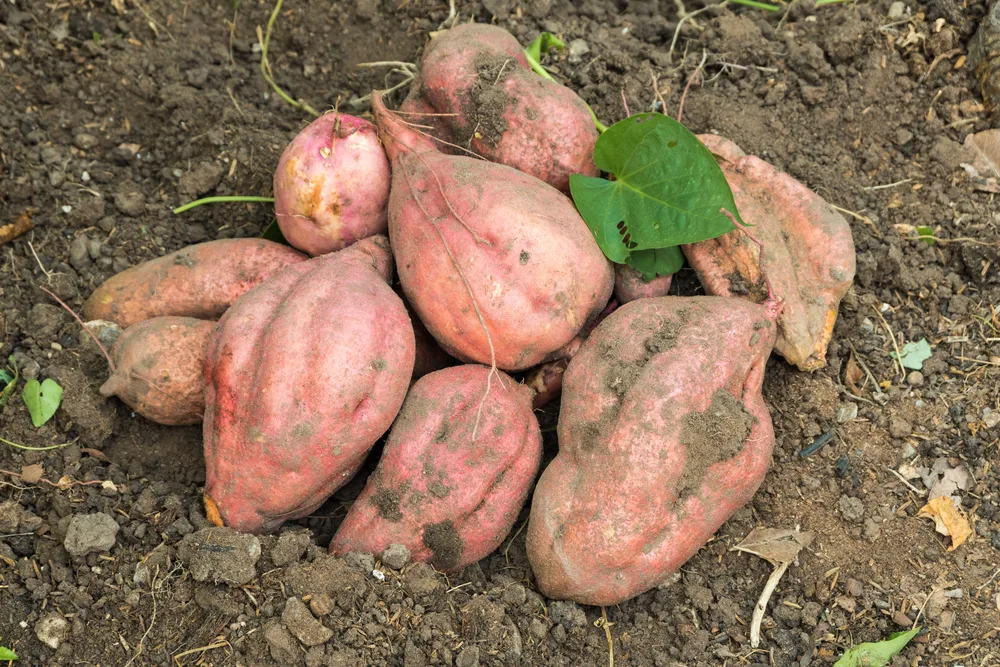
The sweet potato, Ipomoea batatas, is a member of the bindweed or morning glory family, Convolvulaceae.
The plants form large, sweet, tuberous roots which are commonly used as a root vegetable. The young leaves and shoots are sometimes also eaten as greens.
While sometimes called ‘yams’ in North America, the sweet potato is actually botanically very different to true yams (Dioscorea ssp.).
Native to the tropical regions of the Americas, the sweet potato is a herbaceous perennial vine. Though perennial in its native range, it is usually grown as an annual summer crop in temperate climate zones.
It has no tolerance to frost, and grows best at a temperature of at least 75 degrees F. (hence why it must usually be grown undercover in cooler temperate climate zones, where this temperature may not be maintained even during the warmest months of the year).
These plants do not like to be in soil colder than 50 F. and will usually go dormant at temperatures below 60 F.. So these things are important to bear in mind when considering whether or not you can grow them without protection where you live.
Sweet potatoes flower in their native range, but will rarely do so when the daylight is longer than 11 hours (as is normal outside the tropics). For this reason, true seeds are rare.
So sweet potatoes are usually propagated by means of stem or root cuttings, or, most commonly, from adventituous shoots called ‘slips’ which grow from the tuberous roots during storage.
Why Grow Sweet Potatoes?
Sweet potatoes are of course grown for their edible yield. The tubers can (as you will discover later in this article) be cooked in a range of different ways.
But sweet potatoes can also be a useful crop while in growth in the garden.
In warmer climes, where the plants are perennial, they can be a great sustainable choice. These are a crop, in the right conditions, that can keep going year after year.
Where the weather is warm enough, they are amazingly un-fussy, and can grow in a broad range of soil types. They are also relatively drought tolerant.
In optimal conditions, sweet potatoes can also be a great ground cover plant. They spread prolifically (with edible greens) to cover the soil, reduce moisture loss and erosion, and suppress weed growth.
Where Can You Grow Sweet Potatoes?
In tropical and subtropical regions, sweet potatoes will grow well almost anywhere. They can thrive on a range of different soil types in these and in warmer temperate climates. They can be grown even in relatively poor soils, with little fertilizer. In cooler temperate zones, they will do best in light and medium textured soils, with a pH of between 4.5 and 7.
As mentioned above, in cooler climate zones, with cooler summers and shorter growing seasons, some form of cover or protection will be necessary. Growing sweet potatoes inside a greenhouse or polytunnel structure can be the best option in these regions.
Choosing Sweet Potatoes
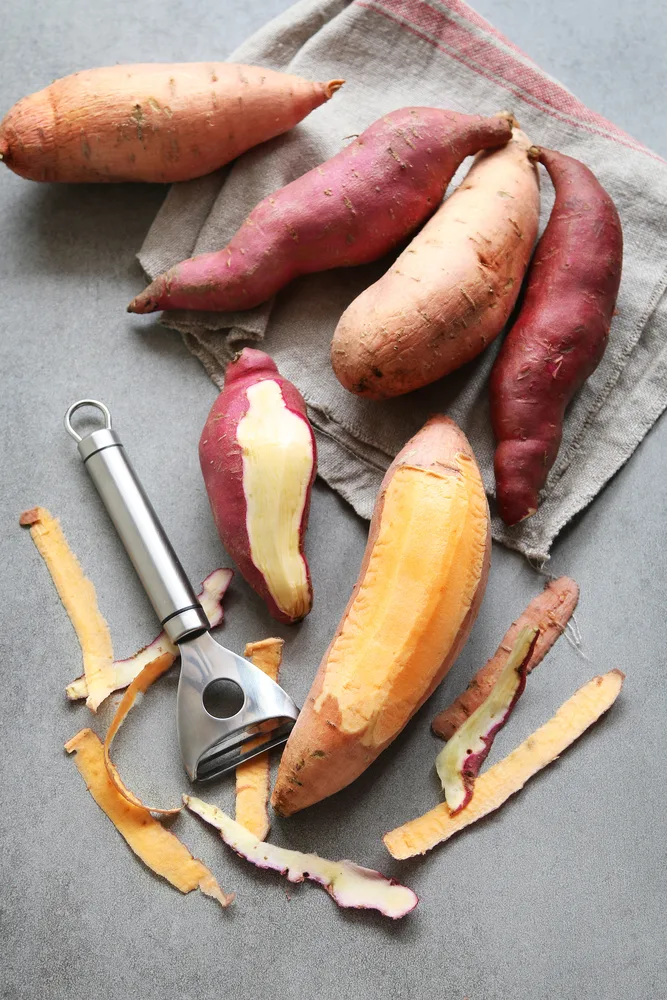
One of the great things about sweet potatoes is that there are a number of different cultivars to choose from.
Most people are familiar with the bright orange colored sweet potatoes. But these plants also produce varieties with white, or purple hues. There are a range of heritage or heirloom options to consider.
For those in cooler climates with shorter growing seasons, choosing hardy and fast-maturing varieties is particularly important.
Some varieties to consider, especially in such regions include:
- Beauregard/ Beauregard Improved
- Georgia Jet
- Centennial
- T65
- O’Henry (compact and suitable for growing in large containers).
- Bush Porto Rico (another option for containers and smaller gardens).
It is a good idea to speak with experienced growers in your own area to find out which varieties might be best suited to growing wherever you live.
In the US in particular, you will tend to find ‘old timers’ who have been growing heritage varieties for years.
These may even have been passed down through families since the earliest days of European settlement.
Sweet potatoes have been grown (especially in the south east of the United States) for most of the nation’s history.
Planting Sweet Potatoes
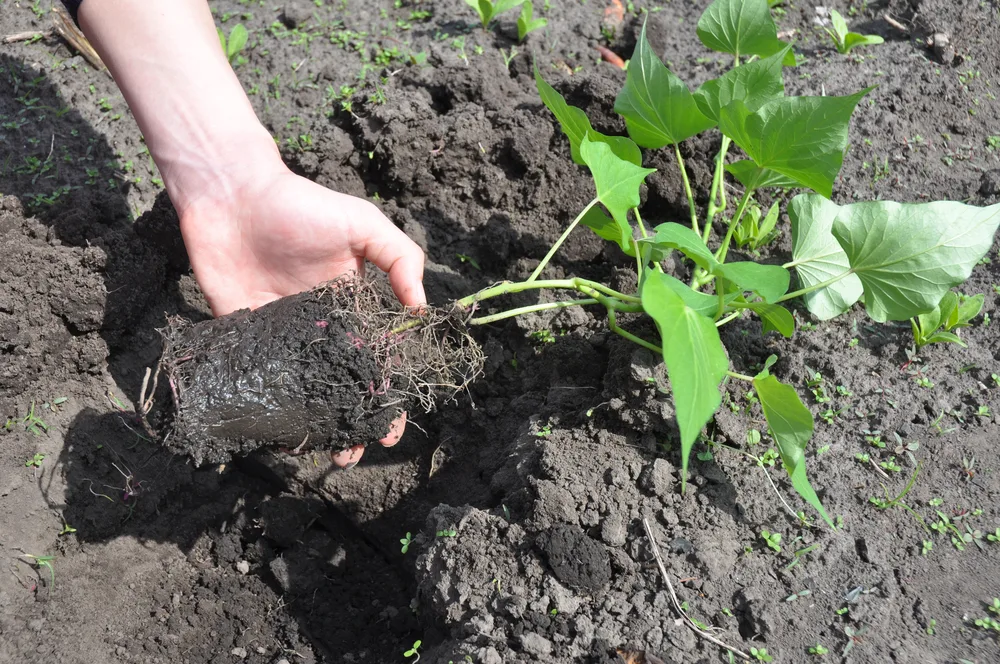
Sweet potatoes, as mentioned above, are most commonly grown from slips. You can often purchase slips or young plug plants.
However, you can also make your own slips from any sweet potato. It is best to choose seed sweet potatoes from a reputable supplier, which will be disease free. But in a pinch you can try this with any sweet potato from a store.
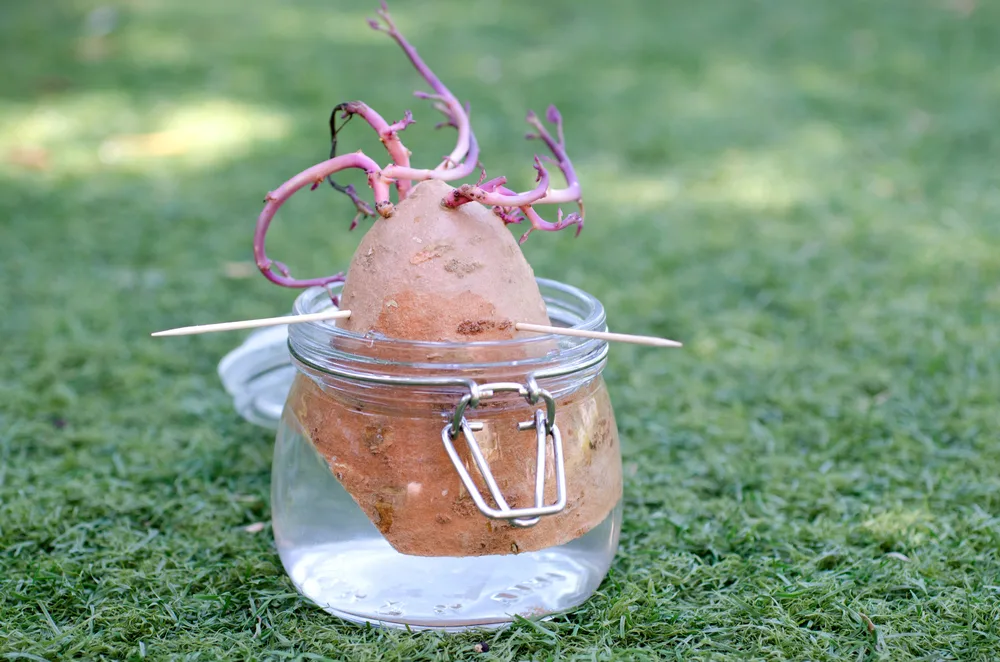
- Cut the sweet potato in half lengthways and place it on a tray or container of suitable growing medium.
- Cover the pieces with an inch or two of soil and keep the tray warm and moist.
- After a few days, small roots should begin to emerge.
- Shortly thereafter, green growth should emerge.
- You can then plant out these slips into your containers, polytunnel or greenhouse, or outside growing areas that you have prepared. They are ready to plant out when they are around 4-8 inches tall. (They should reach this stage in around 6 weeks).
If you have a short winter, you can also begin new slips from vine cuttings.
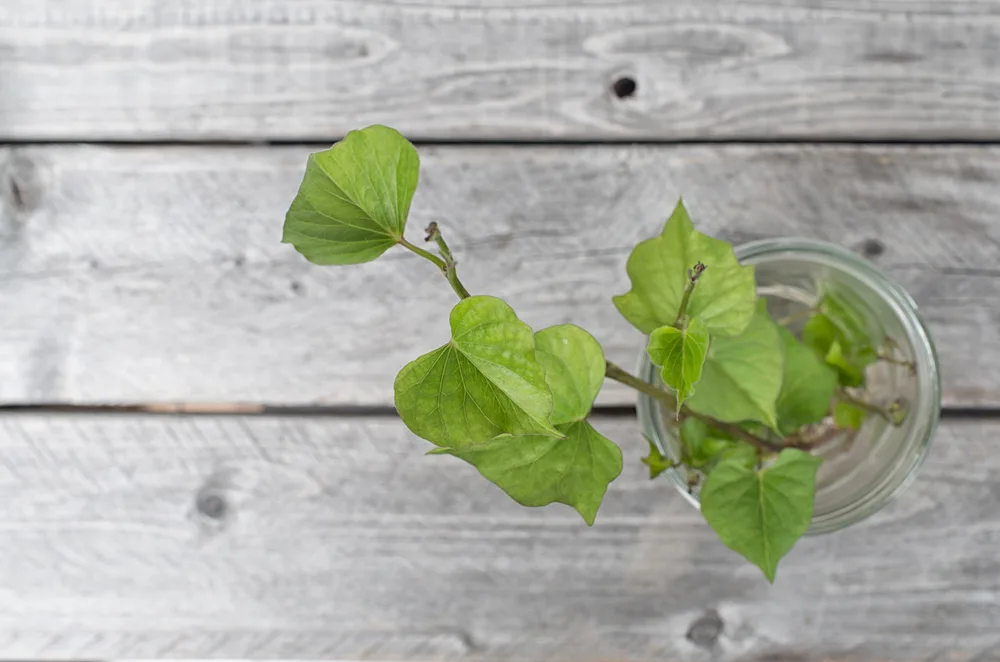
Cut off the top 6 inches or so from the tips of the vines, before the first frost. Place these cuttings in water and once roots develop, plant them in soil and keep them in a warm and sunny spot until the soil outside has warmed sufficiently to plant them out.
Be sure to wait to plant out your slips until all danger of frost has well and truly passed. The soil must be at least 60 degrees and ideally closer to 85 degrees F. And the air temperature should be between 65 and 95 degrees F. for optimal cropping.
Companion Plants for Sweet Potatoes
In order to get the most from your garden, companion planting can be a good idea. Certain plants can aid one another and may improve your overall yield. Good companion plants for sweet potatoes include:
- Bush and climbing beans. (nitrogen fixers)
- Root crops such as carrots, parsnips and beets.
- Aromatic herbs such as summer savory, thyme, oregano and dill which may help repel pests.
Remember that sweet potato vines will often take up quite a lot of space and spread to cover the bed. Avoid planting with squash and pumpkins which will compete for space and nutrients.
You should also avoid planting corn or any other tall plants where they will cast too much shade and reduce the temperature of the sweet potato growing area.
Caring For Sweet Potatoes
Make sure that you plant sweet potatoes in a soil high in organic matter which is relatively light and free-draining and yet which can retain water and nutrients.
You should not need to fertilize your plants, though adding a mulch to slowly release nutrients over the growing season and conserve moisture can be a good idea.
Sweet potatoes can tolerate dry conditions, but it is best to keep soil evenly moist, providing around an inch of water once a week throughout the summer months.
Stop watering a month before expected harvest time, to keep the mature tubers from splitting.
Remember, as you progress through the summer months, that you can harvest the leaves for greens as long as you do so little and often and do not take too much at the same time. Lifting vines occasionally to harvest leaves will also prevent them from rooting in, which will only create competition for the main root section.
Even where these act as a perennial, it is best to treat them as an annual in your garden since this can allow you to rotate crops and avoid a number of diseases. Crop rotation can also reduce the incidence of pest problems. Look out for mice and other rodents which may eat the tubers, and use physical barriers if necessary to keep critters at bay.
Harvesting Sweet Potatoes
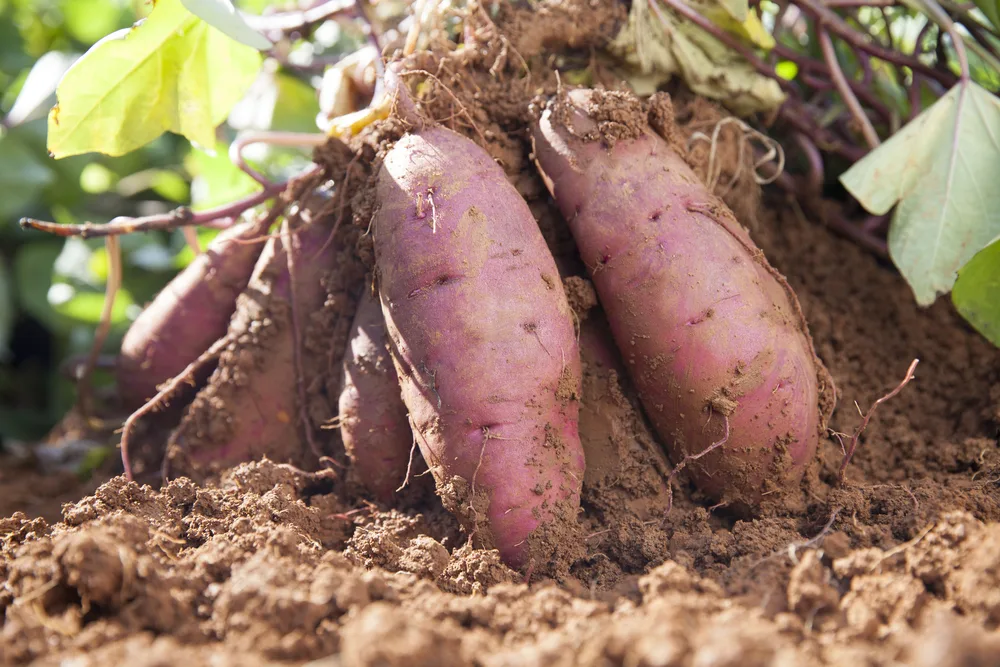
Most sweet potatoes should be ready for harvest around 90-120 days from planting. The exact time to maturity will depend on the conditions where you live, and also, of course, the variety that you have chosen to grow.
You will be able to tell when the tubers are ready to harvest because the foliage will begin to yellow.
If your crop is hit by a frost towards the tail end of the season, the tubers may well still be fine. Just be sure to harvest them as soon as possible. Don’t let them sit in the soil or they will very quickly begin to rot.
Be careful when digging out the tubers. They are close to the surface and their skins are very tender, so they can easily be bruised or damaged. Gently unearth the tubers. Use up any bruised or damaged tubers more quickly, and choose the best, unblemished examples to store.
Storing Sweet Potatoes
In order to store sweet potatoes for longer periods, you should cure them. Curing means leaving them in the sun for a day to dry out. Then placing them in a humid location out of direct sunlight for a further couple of weeks. Once you have done this, you can generally store tubers in a cool, dry location for up to 5 months.
Here’s our guide for storing potatoes for long term preservation. The same principles apply with sweet potato storage.
You can also freeze cure sweet potatoes. Cook them in water, steam, in a pressure cooker or in the oven and they can be cut into halves, cubes, slices or mashed. They can then be placed into containers, sealed and frozen for a year or more.
If you have a pressure canner, or other canning equipment, there are also a number of methods you can use to preserve your sweet potatoes for later.
Using Sweet Potatoes
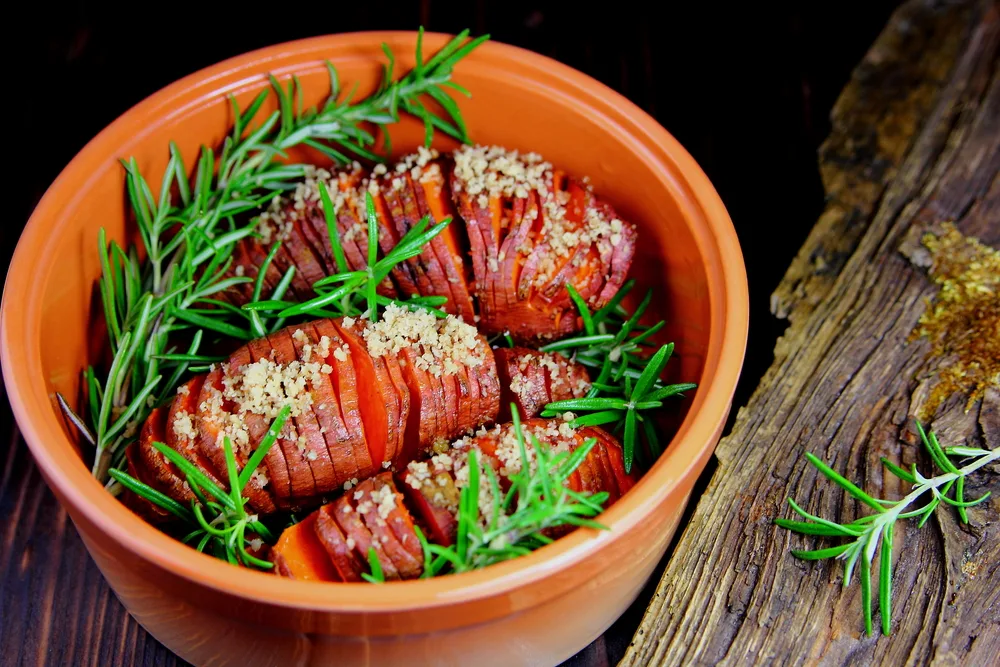
Sweet potatoes are a versatile ingredient. They can be used in a wide range of different recipes, both sweet and savoury. Here are just a few recipe ideas to consider:
- Sweet Potato Pie @ allrecipes.com.
- Sweet Potato Brownies @ chocolatecoveredkatie.com.
- Oven-Roasted Sweet Potato Fries @ gimmesomeoven.com.
- Vegan Sweet Potato and Kale Bake @ cookingwithplants.com.
- Mediterranean Baked Sweet Potato @ minimalistbaker.com.
Of course, those are just the beginning. There are plenty of ways to cook and eat sweet potatoes. You can eat them for breakfast (with yogurt and maple syrup), for lunch (in a warm salad or pasta bake) or for dinner, in an almost endless number of ways.
So, if you can, you should definitely consider growing sweet potatoes in your garden.

Get the famous Rural Sprout newsletter delivered to your inbox.
Including Sunday musings from our editor, Tracey, as well as “What’s Up Wednesday” our roundup of what’s in season and new article updates and alerts.


